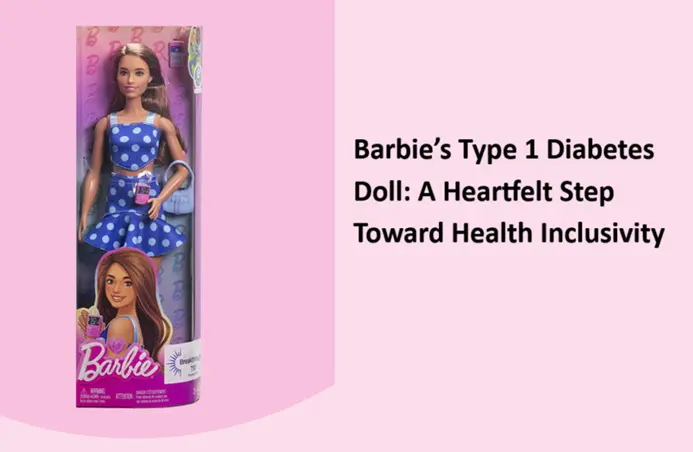
Barbie Type 1 Diabetes Doll A Heartfelt Step Toward Health Inclusivity
In 2025, Barbie’s first-ever doll with Type 1 Diabetes (T1D) is breaking barriers, blending pop culture with powerful healthcare advocacy. Featuring a glucose monitor and insulin pump, this doll, launched with Breakthrough T1D, inspires kids and reduces stigma around chronic illnesses.
Imagine being a child with Type 1 Diabetes (T1D), navigating a world where your daily reality—insulin pumps, glucose monitors, and constant health checks—feels isolating. Then, picture opening a toy box to find a Barbie who looks just like you, proudly wearing a tiny continuous glucose monitor (CGM) on her arm and a Barbie-pink insulin pump clipped to her waist. In 2025, this heartwarming vision became reality as Mattel, in partnership with Breakthrough T1D, launched its first-ever Barbie doll with T1D. This isn’t just a toy—it’s a bold, emotional step toward inclusivity, sparking joy and hope for millions of kids and families worldwide, including in India, where diabetes affects over 77 million adults.
The T1D Barbie is more than a doll; it’s a symbol of empowerment. With authentic medical gear, including a CGM and insulin pump with vibrant pink medical tape, she shows kids that managing a chronic condition doesn’t dim their sparkle. “Representation matters,” says Dr. Anjali Sharma, a Mumbai-based pediatric endocrinologist. “When a child sees their medical devices on a beloved toy like Barbie, it normalizes their experience and boosts their confidence.” This sentiment echoes across X, where posts celebrating the doll have gone viral, with hashtags like #T1DBarbie and #RepresentationMatters trending as parents and advocates share emotional stories.
In India, where diabetes is a growing epidemic—projected to affect 134 million by 2045 according to the International Diabetes Federation—the doll’s launch carries profound significance. For children with T1D, who often face stigma around visible medical devices, this Barbie offers a powerful message: you are seen, and you are enough. “My daughter cried when she saw the doll,” shares Priya Menon, a Chennai mother whose 8-year-old lives with T1D. “She said, ‘Mummy, Barbie’s like me!’ It’s the first time she’s felt proud of her pump.” Such stories highlight the doll’s emotional impact, turning a simple toy into a beacon of acceptance.
The initiative also tackles stigma head-on. Medical devices like insulin pumps are often misunderstood, with kids facing curious stares or questions at school. By showcasing these devices on a global icon like Barbie, Mattel is helping to normalize them. “It’s a game-changer,” says Dr. Rajesh Khadgawat, a Delhi-based endocrinologist. “When kids see their heroes embracing these devices, it reduces the shame and makes them feel like superheroes in their own right.” This aligns with Breakthrough T1D’s mission to educate and advocate, ensuring kids with T1D grow up confident and supported.
But why is this resonating so deeply? The answer lies in its blend of pop culture and purpose. Barbie, a brand synonymous with aspiration, has long evolved to reflect diversity—think dolls with hearing aids, wheelchairs, or vitiligo. The T1D doll takes this legacy further, addressing a chronic condition that affects 1.2 million children globally. On social media, the response has been electric. A viral X post by @Techbabe254, with over 10,000 likes, reads: “Barbie’s T1D doll shows kids they’re unstoppable. This is how we change perceptions!” The doll’s vibrant packaging and relatable accessories make it a shareable sensation on Instagram, too, where parents post photos of their kids beaming alongside their new role model.
In India, where cultural attitudes toward chronic illnesses can carry stigma, the T1D Barbie opens doors for broader conversations. Local toy brands could take inspiration, creating dolls that reflect India’s diverse health challenges, like thalassemia or asthma. “Indian companies should follow suit,” suggests Dr. Sharma. “A doll with a nebulizer or insulin pen could resonate deeply with our kids.” Such initiatives could align with India’s growing healthtech sector, projected to reach $50 billion by 2047, by fostering awareness through play.
Yet, challenges remain. The doll, priced at around ₹2,500–₹3,500, may be out of reach for many Indian families, especially in rural areas where healthcare access is limited. Partnerships with NGOs or government programs like Ayushman Bharat could make such toys more accessible, amplifying their impact. Additionally, awareness campaigns, like those run by Breakthrough T1D, could educate schools and communities, reducing bullying and fostering empathy.
The T1D Barbie is a small but mighty step toward a world where no child feels alone in their health journey. It’s a reminder that representation isn’t just about visibility—it’s about giving kids the courage to shine. Have you or your child been touched by this initiative? Share your story with #T1DBarbie and join the movement for inclusivity!
References: India Today Health, International Diabetes Federation